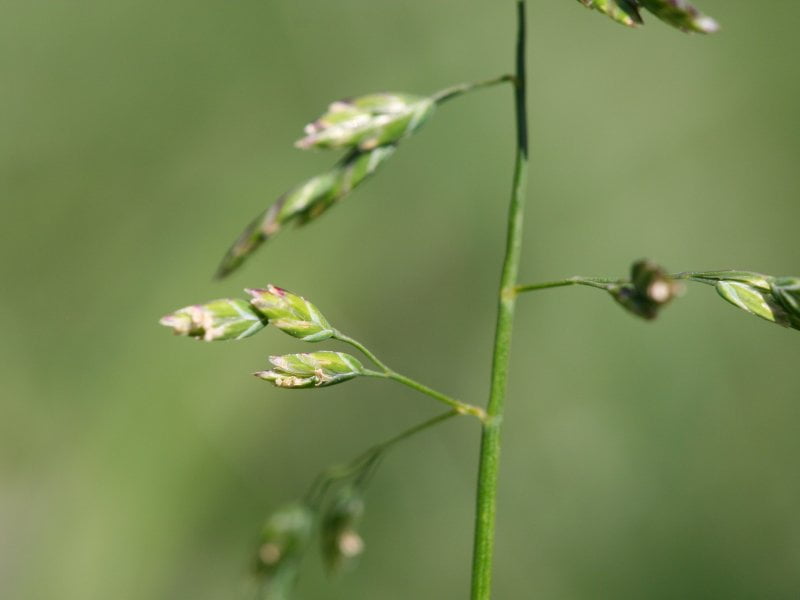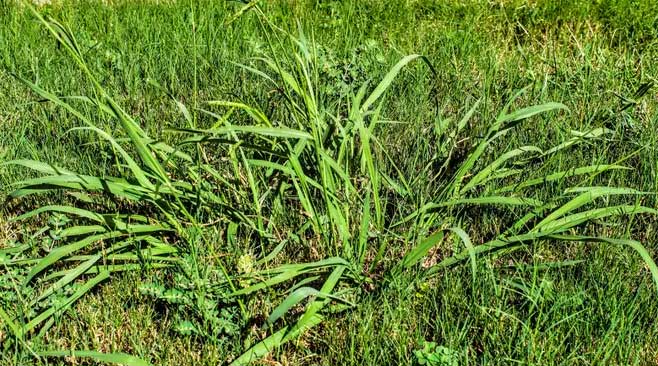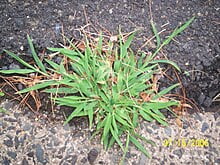You’ve spent a glorious Saturday afternoon meticulously weeding your lawn, feeling a surge of pride as you admire your flourishing green oasis. But wait! A clump of lighter green, wispy grass disrupts your perfect turf, like an uninvited guest at a meticulously planned party.
Could this be the infamous poa annua, also known as annual bluegrass? Or perhaps the notorious crabgrass, a tenacious warm-season weed?
Don’t let these grassy imposters fool you! While both poa annua and crabgrass can disrupt your lawn’s aesthetics, their characteristics and control methods differ significantly. Identifying the culprit is crucial for a targeted attack and a flourishing lawn. We’ll equip you with the knowledge to distinguish these imposters, so you can reclaim your green haven!
Poa Annua: The Sneaky Lawn Invader
The Great Lawn Imposter:
Picture this: you gaze upon your meticulously maintained lawn, a verdant oasis bathed in sunshine. But a closer look reveals a betrayal! A patch of bright green, wispy grass disrupts the uniform carpet, like a cleverly disguised party crasher. This, my friends, is likely poa annua, also known as annual bluegrass.
Finer Blades, Faster Growth:
Don’t be fooled by its innocent name. Poa annua is a persistent grassy weed that thrives in cool, damp weather. Its finer blades, a brighter shade of green compared to your desired turfgrass, often form dense, uneven patches. Unlike some weeds that spread aggressively, poa annua prefers to grow in compact bunches.
A Master of Adaptation:
This sneaky invader is an opportunist, flourishing in less-than-ideal conditions. Compacted soil? Low nitrogen? Poor drainage? No problem for poa annua! This resilience makes it a formidable foe. Traditional lawn care might not be enough, and its prolific seed production fuels its relentless spread.
The Key to Eradication: Identification
While poa annua may seem like a harmless grassy weed, it can quickly take over your lawn if left unchecked. The key to effective control lies in proper identification. In the next section, we’ll delve deeper into deciphering the clues that differentiate poa annua from another common lawn enemy: crabgrass. Stay tuned, and together, we’ll reclaim your green haven!


The Notorious Lawn Brawler: Crabgrass
The Summer Lawn Spoiler:
Crabgrass, a name synonymous with lawn frustration, is another common grassy weed that thrives under the summer sun. Unlike its cool-weather counterpart, poa annua, crabgrass is a true summer annual. It emerges in spring, basks in the warm months, and throws in the towel when frost arrives in fall.
Broad Blades, Brawling Growth:
Crabgrass isn’t known for subtlety. Its wide blades, a stark contrast to your desired turf, sprawl outward from a central point, resembling a crab’s menacing legs (the source of its rather unflattering name). This aggressive growth pattern creates unsightly patches, disrupting your lawn’s pristine uniformity.
A Master of Seed Production:
This summer bully isn’t just a bully; it’s a prolific one. A single crabgrass plant can unleash thousands of seeds, tiny soldiers waiting in the soil for their chance to germinate when conditions are right. This high seed production makes control a constant battle, as even a small patch can quickly transform into a full-blown invasion.
Sunlight, Space, and the Seeds of Trouble:
Crabgrass thrives in open warfare. Sunny areas with bare patches or thin turf are its battlegrounds of choice. Without proper lawn care practices, crabgrass readily establishes itself, stealing precious space, water, and nutrients from your desired lawn.
The Key to Eradication: Identification
While crabgrass may seem like a seasonal nuisance, its relentless spread can wreak havoc on your lawn. Just like with poa annua, the first step to control is proper identification. In the next section, we’ll equip you with the knowledge to differentiate these two lawn invaders and develop a winning battle plan to reclaim your green haven!


The Great Lawn Showdown: Poa Annua vs Crabgrass
Identifying the culprit wreaking havoc on your lawn is crucial for a targeted takedown. But fear not, intrepid homeowner! We’ll equip you with the skills of a seasoned lawn detective to differentiate between poa annua and crabgrass.
Close-up Case Files:
Grab your magnifying glass! Here’s a breakdown of the key distinguishing features to crack this grassy weed case:
- Blade Width:Poa annua, the sneaky suspect, wields finer, narrower blades compared to crabgrass’s wider, more brazen blades.
- Color Scheme:Poa annua favors a bright green, while crabgrass leans towards a lighter green or even a yellowish-green hue.
- Growth Pattern:Poa annua prefers a “bunchgrass” growth habit, forming those dense, uneven patches. Crabgrass, on the other hand, is a spreading menace, creating unsightly mats across your lawn.
Seasonal Shifts:
Timing is everything in the world of lawn detectives. Poa annua thrives during spring and fall’s cooler temperatures, taking advantage of moderate weather and moist soil. Crabgrass, the summer scoundrel, waits for the heat, germinating only when soil temperatures rise above 55-60 degrees Fahrenheit. Observe the timing of the weed’s emergence – a spring/fall culprit points to poa annua, while a summer arrival suggests crabgrass.
The Touch Test:
Here’s an unconventional clue: texture! Poa annua generally feels softer to the touch compared to the coarser blades of crabgrass. While subtle, this tactile difference can be the final piece of evidence you need to confirm your suspicions.
| Feature | Poa Annua | Crabgrass |
| Blade Width | Finer, narrow blades | Wider blades |
| Color | Bright green | Light green to yellow-green |
| Growth Pattern | Bunchgrass growth habit | Spreading, mat-forming |
Become a Master Lawn Detective:
By combining these visual cues, seasonal patterns, and even the touch test, you’ll transform into a master lawn detective! Accurately identifying poa annua or crabgrass empowers you to implement targeted control strategies and reclaim your green haven. In the next section, we’ll explore these control methods to help you win the battle against these lawn invaders!
Eviction Strategies: Banishing Poa Annua and Crabgrass from Your Lawn
Building a Fortress Against Weeds:
The best defense is a good offense! Maintaining a healthy lawn is the first step to evicting poa annua and crabgrass. Think of it as fortifying your green haven against these unwelcome guests.
- Watering Wisdom:Deep and infrequent watering encourages your desired turfgrass to develop strong, deep roots. This makes it more resilient to drought and better able to compete with weeds for precious resources.
- Mowing Mastery:Mowing at the recommended height for your grass type helps shade the soil, hindering weed seed germination and creating a dense lawn that discourages weed growth.
- Fertilization Frenzy:Regularly feeding your lawn with essential nutrients strengthens your turfgrass, allowing it to crowd out weeds and thrive.
Pre-Emptive Strikes: Halt the Invasion Before it Starts
Pre-emergent herbicides are like weed assassins, taking out the enemy before they even sprout.
- Poa Annua Patrol:For poa annua, deploy these pre-emergent herbicides in late summer or early fall, before the weed’s seeds germinate. Timing is crucial, so be sure to follow the product instructions for optimal effectiveness.
- Crabgrass Crusaders:Crabgrass pre-emergent herbicides require a spring offensive, applied before soil temperatures reach the germination threshold for these weeds.
Post-Emergent Power Plays: Eradicate Established Squatters
If poa annua or crabgrass have already infiltrated your lawn, don’t despair! Post-emergent herbicides can target these established weeds. However, wield these tools with caution:
- Selective Strikes:Opt for selective post-emergent herbicides that target specific weed species while minimizing damage to your desired turfgrass.
- Label Law Abiding Citizen:Always follow the product label instructions meticulously. Applying herbicides when the weeds are actively growing ensures maximum effectiveness.
Calling in the Reinforcements: Professional Help for Tough Battles
For severe infestations or persistent weed problems, consider seeking assistance from lawn care professionals. These green crusaders have the expertise and resources to:
- Assess the Threat:They’ll evaluate the extent of the weed infestation and recommend the most appropriate control measures.
- Long-Term Defense:Lawn care professionals can provide ongoing maintenance services to ensure your lawn remains healthy and weed-free, allowing you to enjoy your green haven year-round.
By combining these strategies – cultural practices, well-timed herbicide applications, and professional help when needed – you can effectively banish poa annua and crabgrass, reclaiming your lawn and achieving a lush, weed-free paradise.

Knowledge is Power: Identify and Conquer
The war on weeds is winnable! In the battle against poa annua and crabgrass, the first line of defense is proper identification. Understanding the enemy allows you to deploy targeted strategies, ultimately leading to a healthier and more resilient lawn.
Decoding the Lawn Invaders:
By identifying poa annua versus crabgrass, you gain valuable intel. Poa annua thrives in cool weather and loves compacted soil, while crabgrass basks in the summer sun and readily colonizes bare patches. Recognizing these seasonal preferences and growth patterns empowers you to take proactive measures.
Building a Weed-Free Fortress:
Our arsenal includes cultural practices like proper watering, mowing, and fertilization. These strengthen your turfgrass, making it a less hospitable environment for weeds. Additionally, pre-emergent and post-emergent herbicides, used strategically, provide targeted attacks on these invaders. Implement these methods consistently for optimal weed suppression and a thriving lawn.
The Call to Action: A Lush Lawn Awaits!
Take action today and reclaim your outdoor oasis! Armed with the knowledge from this guide, you can:
- Adjust Lawn Care Practices:Ensure your watering, mowing, and fertilization routines promote healthy turf that can outcompete weeds.
- Implement Herbicide Treatments:Strategically use pre-emergent and post-emergent herbicides to prevent weed germination and eliminate established weeds.
- Seek Professional Help:For severe infestations, consider consulting lawn care professionals for expert advice and ongoing maintenance.
Every step you take brings you closer to achieving a weed-free haven. Don’t let poa annua and crabgrass steal your enjoyment of your lawn. Take control today and reclaim your green paradise! Remember, a lush and thriving lawn is just a few informed decisions away.
Frequently Asked Questions (FAQ) about Poa Annua vs Crabgrass:
Q: Crash Course on Lawn Invaders: What are Poa Annua and Crabgrass?
A: These two uninvited guests can wreak havoc on your lawn. Here’s a quick breakdown:
- Poa Annua (Annual Bluegrass):Thrives in cool weather, popping up in spring and fall with finer blades that form clumps in your lawn.
- Crabgrass:A summertime bully, emerging in warmer months with wider blades that spread in unsightly mats.
Q: Friend or Foe? How Can I Tell Them Apart?
A: Don’t be fooled by their grassy disguises! Here are some key differences:
- Blade Width:Poa annua has finer blades, while crabgrass wields wider ones.
- Growth Pattern:Poa annua prefers to clump together, while crabgrass spreads out in a mat-like fashion.
- Seasonal Clues:Poa annua thrives in cooler temperatures, while crabgrass loves the summer heat.
Q: Why Bother? Why Should I Control Poa Annua and Crabgrass?
A: These lawn invaders are more than just eyesores. They compete with your desired turfgrass for essential resources like water, sunlight, and nutrients. Left unchecked, they can take over your lawn, impacting its overall health and appearance.
Q: Banishing the Weeds: What are Effective Control Methods?
A: A multi-pronged approach is key! Here are your weapons of choice:
- Cultural Practices:Proper watering, mowing, and fertilization create a healthy lawn less susceptible to weeds.
- Pre-Emergent Herbicides:Act as weed assassins, preventing seeds from germinating (apply in late summer/fall for poa annua, spring for crabgrass).
- Post-Emergent Herbicides:Target established weeds when they’re actively growing.
Q: Timing is Everything: When to Apply Herbicides?
A: Strike first! Apply pre-emergent herbicides before weed seeds germinate (refer to application times mentioned above). For post-emergent herbicides, target actively growing weeds for maximum effectiveness.
For further exploration of gardening articles, kindly visit our webpage: Home Garden
17 Fastest Growing Cactus Species for Your Thriving Garden
7 Plants That Look Like Foxglove – Toxic + Safe Look Alike
Red Creeping Thyme Texas Tough & Fragrant Groundcover (Fast-Growing!)
Foxglove Look Alike: Unveiling Safe Lookalike Plants (Avoid Toxic Confusion!)
Zinnia Companion Plants: Attract Pollinators For a Thriving Garden
Useful Links
Poa annua Click here
crabgrass Click here
ABOUT THE AUTHOR
M. Waseem Khalid is a respected product reviewer at Home Garden Glow. He has a strong educational background, including an MBA in Marketing and a Post graduate Diploma in Information Technology. With many years of experience, Waseem has become well-known for his expertise in analyzing and critiquing products. He combines his deep understanding of marketing with the latest technological insights to provide valuable reviews.

